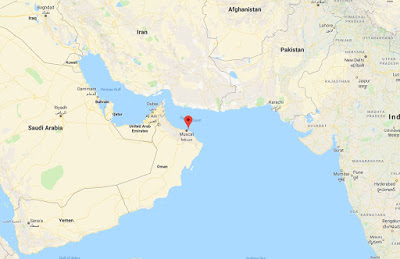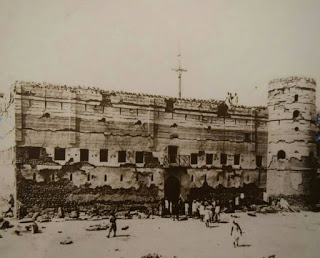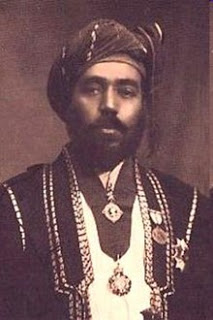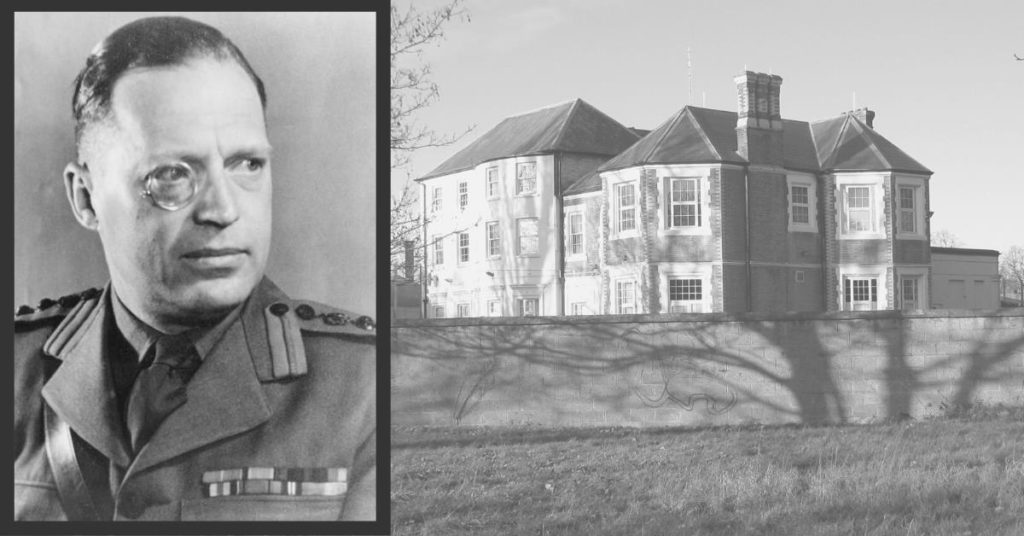I’ve known for a while that Robin W.G. Stephens, commandant of Camp 020, had spent some years in Muscat during the late 1920s. The more I dug into the Muscat Levy Corps, however, the more perplexed I became. What was a British officer doing commanding a group of soldiers, drawn from what is now Pakistan, in the deserts Oman? Before we get to Stephens, therefore, we need to back up a bit and get some context.
History of Muscat

Muscat lies on the eastern coast of the Arabian Peninsula, part of what is now Oman. Back in the 1500s, Muscat was a convenient way-point for ships traveling between Europe and India and the first Europeans to control the area were the Portuguese. Their superior naval tactics allowed them to gain control of the coastal area from local leaders thereby allowing them to expand their profitable spice trade with India.
By the mid 1600s, the British, in the shape of the British East India Company, were nosing around the area and signed a treaty with some of the desert tribes in a bid to weaken Portuguese control of the area. In 1650, Imam Sultan Bin Saif rose up and expelled the Portuguese from Muscat and Oman.
Things ticked along quite nicely for several decades, with minimal interference from the British. The Oman empire expanded and eventually included enclaves as far away as Zanzibar and as near as Gwadur (a coastal area in modern-day Pakistan) across the Gulf of Oman.
All was well until the late 1700s when Napoleon started challenging the British in Egypt. The British government became more directly involved and signed several treaties with the Omani ruling family. In 1856, a succession crisis followed the Sultan’s death and the British stepped in and divided the Omani empire into two. This, along with several other factors (debt), weakened the sultanate and meant that the ruling family became increasingly dependent upon British military and political support to maintain power.
In the early 1900s, conservative anti-Muscat tribes in the interior, sensing a weakness in their foe, stepped up their attacks on the Sultanate. Propped up by British military and political support, the Sultan held the tribes at bay, but there was no clear-cut victory for either side. Finally, on 25 September 1920, the British government brokered the Treaty of Sib between the Sultan of Muscat and the Imam of Oman. In return for autonomy, the interior tribes promised to cease attacking the coastal communities. The British preserved their power through the Sultan and the Sultan received a loan from the British which allowed him to pay down his debts.
Muscat Levy Corps

Most of the British military support during the tribal rebellions in the early 1900s came in the form of troops from the Indian Army.
A fort at Bayt al-Falaj, near the Sultan’s summer palace, became the headquarters of the force and the surrounding village soon became an army encampment.
On 19 April 1921, a year after the Treaty of Sib had been signed, replacements for the Indian troops arrived in the form of the Seistan Levy Corps from Baluchistan (modern day-Pakistan) under the command of Captain E.D. McCarthy. The new arrivals set up camp in al-Wutayyah while the Indian Army troops vacated their headquarters at Bayt al-Falaj. Unfortunately, the 250 Seistan soldiers were not used to the climate and malaria decimated their ranks. Many of the soldiers were discharged in the first year and replaced by Makrani Baluchis from the Sultan’s enclave at Gwadur, across the Gulf of Oman.
The Muscat Levy Corps was small in size, never mustering more than 300 men, and usually 200 or less. Its role was primarily that of a garrison force, providing armed guards for the Sultan’s Palace, the British Political Agency and the Sultanate Treasury. In 1923, the first commandant, Captain McCarthy, handed command of the Muscat Levy Corps (MLC) to Captain R.G.E.W. Alban. Given the poor economic condition of the Sultanate, the MLC suffered from budgetary constraints which manifested in the form of inadequate firearms and a declining roster. It would appear that Captain Alban was invalided unexpectedly in March 1924 and his successor, who arrived in July 1924, was Captain George J. Eccles.
Captain R.W.G. Stephens, Commandant of the Muscat Levy Corps

On 11 May 1926, Captain Eccles wrote his final report on the MLC and handed over command to Captain Robin William George Stephens, seconded from the Indian Army.
For the next two years, Stephens took the Corps in hand. His report, dated 11 May 1928, gives us a good sense of the state of the Corps and how he sought to improve discipline and efficiency.
The Corps consisted of one Commandant, three Indian officers and 165 other ranks: two platoons of Muscat Arabs, two platoons of Makrani Baluchis and one platoon of Muscat State subjects. Stephens noted that when he took command, the Corps mustered 180 troops despite the fact that Eccles had considered 200 to be a minimum. The climate proved to be a complicating factor. During the rainy season, malaria was a danger while during the dry months, boils were the main problem. Discipline was generally excellent, particularly after Stephens started an Officers Club and an NCO’s Club. This reduced the intermixing of officers, NCOs and troops which Stephens noted could “be so detrimental to discipline”. Stephens worked at increasing the marksmanship of the soldiers, despite the fact that they were issued with older rifles. Finances were an ongoing issue and Stephens had tried to reduce the budget, as had his predecessor.
As for the role of the Muscat Levy Corps, Stephens noted that there was no occasion to use the troops to deal with hostile people and so their work mainly consisted in the maintenance of Bayt al-Falaj, providing guards and furnishing ceremonial duties. In addition, Stephens had the troops repair the rudimentary road between Matrah and Bayt al-Falaj, construct a road between Matrah and Muscat and construct a road to Ruwi and then onwards to Bawshar and al-Sib.

In addition to road work, the troops also cleaned out the water channel from Ruwi to Bayt al-Falaj, put the grass farm in Ruwi in order and cleaned out the water channel at al-Wutayyah. Stephens noted that the Sultan had expressed a wish that a pipe band be instituted and a beginning was made despite the lack of trained pipers. Finally, the troops built a tennis court “that added much to the amenities of the place”.
In 1928, Stephens handed over command to Captain A.R. Walker who noted that “Captain Stephens had brought the Corps to a very satisfactory state of discipline and smartness”. Major Fowle, Political Agent & H.B.M.’s Consul in Muscat, noted that “the men are cheerful, well turned out, smart in handling their arms and keen on regimental games and sports”.
In contrast to his reports from the 1940s regarding the work of Camp 020, Stephens’ report on the Muscat Levy Corps is measured and objective without his later flair for the dramatic.
Sources
Historical Muscat: An Illustrated Guide and Gazetteer (2007) by J.E. Peterson
Oman’s Insurgencies: The Sultanate’s Struggle for Supremacy (2008) by J. E. Peterson
British Empire website – background info on Oman
Britannica website – article on Āl Bū Saʿīd dynasty
Qatar Digital Library – Muscat Levy Corps documents from British Library – includes reports by Muscat Levy Commandants: Eccles, Stephens and Walker.
Webstagram – Sultan’s Armed Forces Museum – picture of the fort at Bayt al-Falaj
